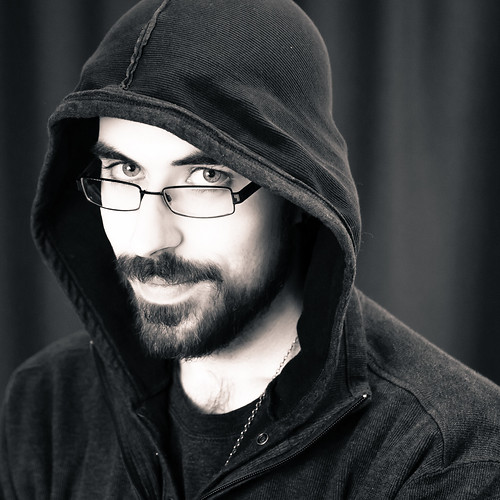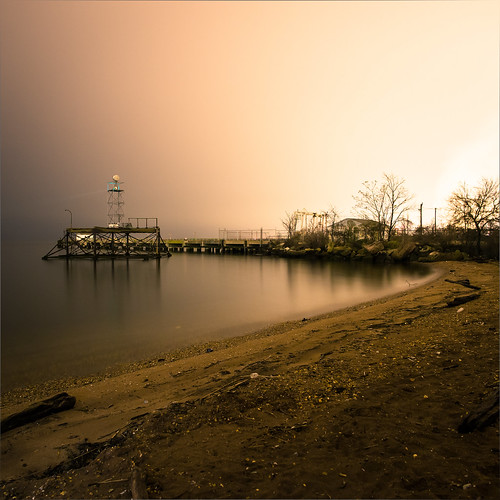Possibly the most frustrating aspect of the process of modern photography (and please keep in perspective the adjectives "modern" and "photography" in this diatribe... digital artists don't necessarily count) is in the editing. What's worse, it's often a self-inflicted aggravation, and one that is painfully difficult to bypass. In the context of my own experiences, when I first dove into the world of photography I was amply satisfied with a basic JPG popped right out of the camera's processing engine. Tack on a year or two and I'm still shooting JPG, but tweaking sharpness, contrast, saturation and color profiles to get it to look just a little more the way I want. Another year or two and I'm using in-camera editing options to soften skin tones and adjust tone curves and color temperatures, cropping and the classic "convert to black and white". The choices were there, albeit limited in scope and largely dependent on shooting it right the first time. Paired with minimal Photoshop tweaking they should've been the last step. The "more than good enough". Nope, eventually all of us who stick to the photography game long enough can't help but step into the RAW waters. And immediately the wealth of choice and complete lack of restraint was... crippling.
I must be clear about this point, I am in the camp of people who demand an absolute balance in all things. When I go to the grocery store and am presented with 4 or 5 different brands of coffee to choose from, at different levels of quality and price point, I am comfortable with my ability to decide and commit. Should I ever step into a coffee supplier warehouse, be faced with literal HUNDREDS of brands of neblous differences in quality and similarly vague price-to-quality values... I'd sooner burn the warehouse down than decide on a bean. While choice is a wonderful, valuable thing to have, the oversaturation of it is downright crippling.
I've been committed, more or less, to RAW shooting for the last 3 years and have yet to really find a fashion of processing with it I can comfortably commit to. Shooting strictly in JPG, options for image alteration were limited by the lossy format, but with RAW the sheer wealth of image data allows for such reckless manipulation of the image that a single frame can go from low key to high key portrait, balanced and flat tones, it can glow with intense softening or be a gritty, textured black and white. Options galore, and while some people do take the route of multiple uploads of the same frame processed in different styles, my innate application of psychology plays too heavily against that route - redundance of the same image, the same subject, inevitably numbs the audience to the subject, and the first time the audience views the subject determines the lasting impression that audience retains of it. So, in short, when I process and share an image for the first time, I am establishing the basic imprint that subject has on that audience, and it is damn hard to decide how I want the audience to feel about a subject in that permanent fashion. Especially when I have a wealth of messages I could communicate with my processing in a single image.
In my mental process of creating an image, however, that paralysis-by-choice is not present until I sit down at the computer to edit an image, usually some hours, if not days, after its capture. At the images inception, in the moments it is constructed and taken, the scene has an impact on me immediately, the scene conveys a point to me and it's very clear what message I want to share. The rub of that, of course, is that the feeling has typically faded by the time it comes to process. Were I to fine tune a JPG I could probably capture the scene perfectly with the impact it originally presents to me, however, another rub of the lure of RAW, I've become spoiled by the elasticity of the RAW files, and although my relationship to it may be begrudged, I know the breadth of editing the format opens up allows for the development of images with that much more impact. But, again, with so much time between capture and processing, even if I were to run immediately home and load the files up I would be completely frozen by a million what-ifs.
Now onto my proposed solution(s) for this quandary.
The first step involves my standards for images I elect "worthy" of processing. My galleries only offer a meager fraction of the actual volume of images I produce. Many photos I take are in candid situations, time spent with family and friends, portraits well enough composed on their own but not deliberate nor controlled. Four years ago that style of portraiture was my highest echelon, my standard, but since the growth I've experienced has elevated that standard, those candid photos often fall by the wayside when they really shouldn't. Just because an image is not artistically considered in every facet does not mean it should not be shared, especially given the capture of emotion possible with images taken in that context. My solution regarding these images, while not to deeply process them as I would my far more deliberate captures, is in the liberal use of Lightroom presets I've collected from several reputable sources. Minor tweaks combined with preset adjustments have produced images that, while not necessarily high art or gallery-worthy, are attractive and appealing in their own right and I have begung sharing them en masse across the social networks I befouled but a few months back. And they've been received in an unexpectedly positive fashion. Enough so to prompt my consideration of my next step in the process of letting go of my strict standards of processing.
For some time Olympus has had available it's PENPal PP-1 accessory, a hotshoe mounted bluetooth transceiver capable of storing, sending and receiving images from the camera to a paired bluetooth device. It never got much traction or popularity what with the simultaneous introduction of wifi SDHC cards into the market and reluctance on Apple's part to implement compatibility with the device (knock out iUsers from the market pool and that's nearly a death-seal for a device like this). In result the product is now super cheap compared to its introductory price point and, fortunately, it is completely compatible with my Samsung Galaxy Tab, a tablet I've owned for 2 years but seen an unfortunate lack of use for barring as a GPS and media player. So... here's the plan.
In the field I can compose and capture the photo as I normally would, even keeping the RAW format for a point later down the road when I may want to doctor the image with great attention to detail. Once satisfied with the capture, I can convert it directly to JPG in-camera, setting color profile, sharpness, contrast, saturation and gradation characteristics, even applying rudimentary skin softening for portrait work and adjusting tone curves (unique perks to we Olympus Elite). With the image as well developed as is possible in-camera, I can then transfer it over to my tablet via the PENPal and open it up in any number of photo editing programs, from Photoshop Express, Snapseed, Instagram, what have you. Depending on the program, an already competently handled image can then be polished and immediately uploaded via 3G connection to a breadth of social networks. And the joy of it is any one of these steps can be skipped depending on the impulse I feel in image handling that day, and should I fail to find interest in editing a RAW at the time or feel it is too high quality to suffer such barbaric edits, the RAW file can just as easily be loaded up into Lightroom for a more refined approach.
Editing on-the-fly. It's a belligerent and defiant approach to the post-process compared to the cripplingly strict set of standards I've come to apply to my choice of processed images. And while there is still a wealth of choice involved in the options of how a photo will be edited, the span of choice is still defined by its limitation given the way tablet and smartphone based photo sharing apps are by trend and nature. Editing on the tablet will either result in a hyper-stylized image using an intense preset filter effect, small, subtle adjustments of a couple key image parameters lending a gentle refinement of the image or a combination of the two. It will all be very basic and unrefined, but that is exactly what I need at this point in my growth as a photographer. Far too often I'm shoving my head in the sand, opting to ignore trends, opting to close myself off to experimentation for sake of a cookie-cutter process and cookie-cutter images lacking in that charming expression brought about only by a willingness to play around. Sometimes it's not the "perfect" shot from the model shoot, but the goofy out-take with the genuine laughter that really comes forth and calls attention. Both have their place, neither is worth neglecting.
Assuming I latch onto this new approach to the post-process, a newer, high resolution 10-inch tablet would certainly be in order. The Nexus 10 comes to mind immediately. A newer tablet with a newer version of Android would open me up to the Adobe Photoshop Touch software, a much more comprehensive photo editing tool that would favor a tablet with larger screen and retina-burning resolution. Add in pressure sensitivity response to any utilized stylus and you have a tool designed with photographers in mind.
I feel it could be applicable to the business aspects of photography as well. For some time now I've been trying and failing to develop a solid portrait market, always falling short due to an inability to narrow down a target market and appeal to them directly. As of yet, it's still just friends and friends of friends, which I can't really complain about because it's still fun and good practice. But introducing tablet-based editing to the picture, I could easily see handling a candid shoot for an hour or so on-location, then heading to the nearest coffee house, grabbing a latte and sitting down with the subject to sort through the images, pick the winners, transfer them to the tablet and edit them not just to my taste, but to the subject's. Collaborative portraiture, eliminating the wall between photographer and model in the post-process. It could be an interesting engagement.
More difficult than anything is keeping oneself open to innovation and sweeping changes. It's easy to become stubborn and shoehorn one's entire process into standard battery with no relief, no deviation and far too much self-imposed pressure. Even with the business aspect tossed in, photography is not "srs bzns". It is not a life-or-death affair and with the basics down you are not being pressured or judged by your output. Processing is relatively new dilemma in the photography world, once the realm of graphic artists and dedicated film developers. With the advent of digital, photographers are inflicting upon themselves en masse an extra step that was never theirs before, and it's not necessarily the easiest skill to learn, especially with the constantly changing standards of how and where an image is displayed (we certainly aren't making prints much these days, and show me two screens with the same color rendition and gamma and I'll show you where Jimmy Hoffa is buried). We're learning two skills these days whether we like it or not. No sense in swimming against the current - embrace it, let yourself flow and somewhere downstream, where the waterway forks, you'll know where to float.
Subscribe to:
Post Comments (Atom)







No comments:
Post a Comment